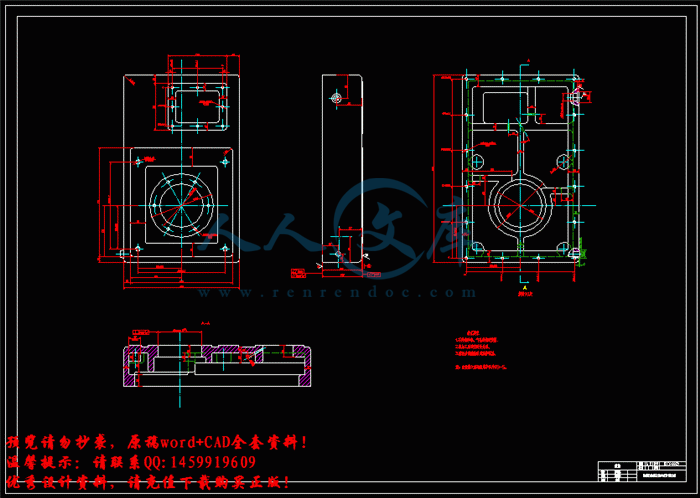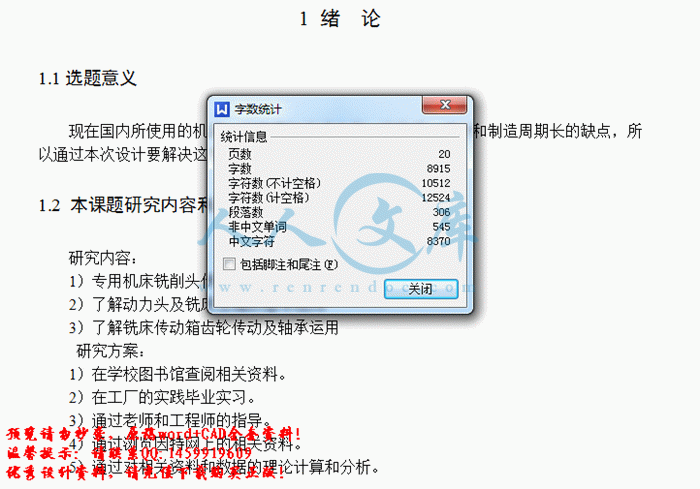专用机床铣削头齿轮传动装置的设计【优秀含3张CAD图纸+机械传动装置全套课程毕业设计】
【带任务书+开题报告+中期检查表+文献综述+外文翻译】【20页@正文8900字】【详情如下】【需要咨询购买全套设计请加QQ1459919609】
专用机床铣削头齿轮传动装置的设计任务书.doc
中期检查表.doc
外文翻译=轴承与齿轮的失效分析=3200字符.doc
毕业论文设计说明书.doc
毕业设计开题报告.doc
毕业设计文献综述.doc
轴展开图A0.dwg
前盖A0.dwg
任务书
毕业设计题目专用机床铣削头齿轮传动装置的设计
毕业设计主要内容和要求:
综合运用所学工程图学、理论力学、材料力学、机械原理、机械设计、金属工艺学、公差与测量、金属材料、机械制造基础、AutoCAD等课程的知识,设计专用机床铣床铣削头尾置式齿轮传动装置。
专用机床铣削头齿轮传动装置,其齿轮传动电机的功率为7.5KW、转速为970r/min,电机位于铣削头的尾部;可变换齿轮的大小以输出:100r/min、125r/min、160r/min、200r/min、250r/min、320r/min共6种转速;与1TX40铣削头配合使用。
设计并绘制专用机床铣削头传动装置的总图及重要零件的工作图。
毕业设计主要参考资料:
[1]蔡春源主编.机械设计手册(第三版).北京:冶金出版设,1996.
[2]吴宗泽主编.机械设计手册.北京:化学工业出版社,1999.
[3]李继庆主编.机械设计基础[M].北京;高等教育出版社,1997.
[4]詹启贤主编.自动机械设计[M].北京:中国轻工出版社,1994.
[5]史西敏主编.精密机构设计[M].上海:上海科学技术出版社,1987.
[6]徐旭东主编.现代组合机床技术及其发展[J]. 中国机械工程 , 1995.
[7]大连组合机床研究所编.组合机床设计[M].北京:机械工业出版社,1975.
[8]吕宣政. 机械加工表面质量对零件使用性能的影响[J]. 池州师专学报, 2003.
[9]沈阳工业大学等编.组合机床设计[M].上海:上海科学技术出版社,1985.
[10]机床设计手册编写组.机床设计手册(2零件设计(下册))[M].北京:机械工业出版社.1980.
[11]戴曙主编.金属切削机床设计[M].北京:机械工业出版社,1985.
[12]李富根.AutoCAD2004基础与实例教程[M].北京:北京希望电子出版社,2003.
[13]王德权,刘彬.组合机床CAD系统开发与研究[J].组合机床与自动化加工技术,1999.
毕业设计应完成的主要工作:
设计并绘制专用机床铣削头齿轮传动装置的总图及重要零件的工作图;编写设计说明书。
毕业设计进度安排:
序号毕业设计各阶段内容时间安排备注
1查阅资料,完成开题报告;2014.12.10—2015.1.20
2外文资料阅读,完成英文翻译; 2015.1.21—2015.2.10
3熟悉有关的资料,完成文献综述;2015.2.11—2015.2.25
4拟定总体方案2015.2.26—2015.3.10
5设计并绘制传动装置的总图2015.3.11—2015.3.25
6设计并绘制齿轮传动装置重要的零件图2015.3.26—2015.4.20
7整理资料,编写设计说明书;准备答辩。 2015.4.21—2015.5.11
摘 要
专业铣床是根据具体情况的需要,对机床进行合理的设计,使其满足加工要求,在现代机械加工中,专用机床是一种专门适用于特定零件和特定工序加工的机床,而且往往是组成自动生产线式生产制造系统中,不可缺的机床品种。专业机床兼有低成本和高效率的优点,在大批、大量生产中得到广泛应用,并可用以组成自动生产线。目前,专业机床研究正向高效,高精度,高自动化方向发展。
本次设计是对专业机床铣削头齿轮传动装置的设计,使其满足对特定零件和特定工序加工的要求,在这一设计过程中,考虑加工时的切削参数,合理的选择电动机的功率,并完成对变速箱里的各级齿轮之间的传动配合的设计和传动轴的设计,充分的考虑到传动时所产生的一系列要求,例如:传动比,传动扭矩,传动功率等。
关键词:传动装置; 齿轮; 轴
Abstract
Professional milling machine is based on the needs of specific circumstances, the machine properly designed to meet the processing requirements of modern machining, a special machine is specifically adapted to a particular part of the machine and specific processing procedures, and often form an automatic type production line manufacturing system, essential tools varieties. Professional tools both low cost and high efficiency advantages, are widely used in large, mass production, and can be used to form an automatic production line. Currently, professional research tool forward efficient, high-precision, high automation direction.
This design is a professional machine milling head gear system designed to make it meet the specific parts and machining processes specific requirements in this design process, consider cutting parameters during machining, reasonable choice motor power, and completion of the design and the design of the drive shaft in the gearbox with gear between levels, taking into account the full range of requirements for transmission generated when, for example: gear ratio, transmission torque, transmission power, etc.
Keywords: Gearing; Gear; Axis
目 录
1 绪 论1
1.1选题意义1
1.2 本课题研究内容和本课题研究方案1
2设计任务1
3齿轮传动装置设计方案1
3.1 电动机的概述1
3.2 电机包装及储运2
3.3 选择电动机的类型和结构型式2
3.4 铣削头传动基础基准选择5
3.5 铣削头在基础上的固定和调整6
3.5.1 固定方式的选择6
3.5.2 铣削头在基础上的调整6
4动力头的结构及零部件的设计7
4.1 动力头的总体结构7
4.1.1箱体7
4.2 联轴器7
4.3 轴承盖9
4.4 齿轮轴10
4.5轴的计算10
5绘制总图13
结 论14
参考文献15
致 谢16
1 绪 论
1.1选题意义
现在国内所使用的机床,它有着加工成本高,效率低,设计和制造周期长的缺点,所以通过本次设计要解决这些问题。
1.2 本课题研究内容和本课题研究方案
研究内容:
1)专用机床铣削头传动装置设计
2)了解动力头及铣床主轴的基本结构
3)了解铣床传动箱齿轮传动及轴承运用
研究方案:
1)在学校图书馆查阅相关资料。
2)在工厂的实践毕业实习。
3)通过老师和工程师的指导。
4)通过浏览因特网上的相关资料。
5)通过对相关资料和数据的理论计算和分析。
2设计任务
设计专用机床铣床铣削头尾置式齿轮传动装置。
专用机床铣削头齿轮传动装置,其齿轮传动电机的功率为7.5KW、转速为970r/min,电机位于铣削头的尾部;可变换齿轮的大小以输出:100r/min、125r/min、160r/min、200r/min、250r/min、320r/min共6种转速;与1TX40铣削头配合使用。
设计并绘制专用机床铣削头传动装置的总图及重要零件的工作图。
参考文献
[1] 蔡春源主编.机械设计手册(第三版).北京:冶金出版设,1996.
[2] 吴宗泽主编.机械设计手册.北京:化学工业出版社,1999.
[3] 李继庆主编.机械设计基础[M].北京;高等教育出版社,1997.
[4] 詹启贤主编.自动机械设计[M].北京:中国轻工出版社,1994.
[5] 史西敏主编.精密机构设计[M].上海:上海科学技术出版社,1987.
[6] 徐旭东主编.现代组合机床技术及其发展[J]. 中国机械工程 , 1995.
[7] 大连组合机床研究所编.组合机床设计[M].北京:机械工业出版社,1975.
[8] 吕宣政. 机械加工表面质量对零件使用性能的影响[J]. 池州师专学报, 2003.
[9] 沈阳工业大学等编.组合机床设计[M].上海:上海科学技术出版社,1985.
[10] 机床设计手册编写组.机床设计手册(2零件设计(下册))[M].北京:机械工业出版社.1980.
[11] 戴曙主编.金属切削机床设计[M].北京:机械工业出版社,1985.
[12] 李富根.AutoCAD2004基础与实例教程[M].北京:北京希望电子出版社,2003.
[13] 王德权,刘彬.组合机床CAD系统开发与研究[J].组合机床与自动化加工技术,1999.






 川公网安备: 51019002004831号
川公网安备: 51019002004831号